Recent Storm Damage Posts
Differences Between Grey and Black Water
1/3/2024 (Permalink)
 Black water in Stillwater, OK
Black water in Stillwater, OK
What Type of Water Has Appeared After a Flood in Your Home?
The level of concern you should feel after a flood inside your home depends on what type of water has appeared. There is white water, which is plain, clean water with little to no contaminants. You should be able to tell when water is contaminated based on the color and odor, and you should never attempt a DIY fix without professional guidance. Contact professionals in Stillwater, OK who know how to safely handle water damage caused by grey or black water.
Grey Water
Grey water refers to liquids that come out from pipes and other structures that does not contain human waste. This water may contain:
- Fats
- Oils
- Soap particles
- Hair
While this does result in a certain amount of contamination, it is not as severe as it could be, and there is less of a risk of people in the vicinity suffering from health problems caused by exposure. If your household uses natural, biodegradable soaps free or boron, chlorine and sodium, then you will have even less to fear. However, if left untreated, this type of water can slowly grow worse.
Black Water
Water damage from black water is a severe problem that needs to be addressed immediately. When flooding occurs due to a blockage in the sewer system, drains in your house will bring up water contaminated by fecal matter and pathogens. A professional team will need to be brought in to safely remove the waste and the affected drywall.
When you discover water backing up into your home, you need to take prompt action to handle it right away to curtail a disaster. If you cannot tell where the water came from or if it has darkened in color even in the slightest, then you should avoid touching it, because you could end up hurting yourself. Instead, leave water damage remediation in Stillwater, OK to the professionals.
Visit http://www.SERVPROstillwaterguthrie.com for more information on storm damage.
6 Shutter Styles You May Need for Your Home
7/18/2023 (Permalink)
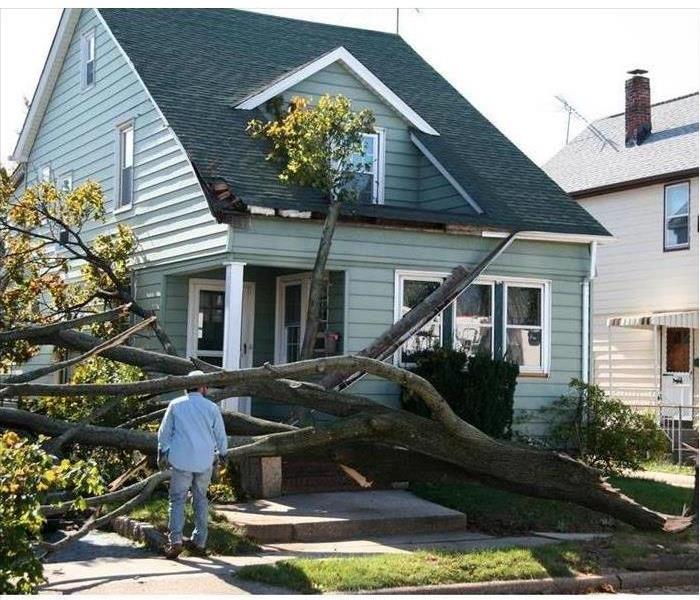 Having your home protected with hurricane window coverings can also save you money in the long run by lowering your insurance premiums.
Having your home protected with hurricane window coverings can also save you money in the long run by lowering your insurance premiums.
If you live in an area that is prone to hurricane and high winds, such as Stillwater, OK, you can mitigate potential damage to your home and protect family by installing storm shutters. Having your home protected with hurricane window coverings can also save you money in the long run by lowering your insurance premiums.
Many types of hurricane window coverings are available. Here are just a few of the more popular options.
1. Plywood
Plywood may not be pretty. However, it is usually an inexpensive, readily available option that can cost less than $1 per square foot of window space.
2. Storm Panels
Storm panels are often an economical option that may only need to be installed if a hurricane is imminent. The cost for these panels is $7-$15 per window.
3. Accordion-Style
Accordion-style window coverings can be stored folded up in a box that is secured to one side of the window. They can then be manually unfolded to cover the window when needed. These shutters often cost $15-$25 per square foot of window space.
4. Bahama Awnings
Bahama awnings can provide shade as well as protect windows from damage by high winds. These shutters can be installed on the tops of windows to provide awnings, and then can be unlatched when you need to cover the window. These coverings may cost about $15-$20 per square foot.
5. Rolling
These window coverings are typically installed in a box bolted above the window. A cranking mechanism unrolls the shutters across the length of the window, and then they are bolted down at the bottom. They can also provide effective insulation, helping to save costs of heating or cooling a home at a cost of $20-$30 per square foot of window area.
6. Colonial
Colonial storm shutters are usually mounted permanently on either side of a window and bolted in place. When needed, they can be unfolded to cover the window. Colonial-style window coverings cost about $200-$500 per window.
Expecting stormy weather? The next time high winds are forecast in your area, you can have peace of mind when you have quality window coverings installed for your home. For more information, visit http://www.SERVPROstillwaterguthrie.com/.
3 Steps To Mitigate Roof Damage To Your Home
6/26/2023 (Permalink)
 It’s a good idea to pay attention to what the weather is doing in your area.
It’s a good idea to pay attention to what the weather is doing in your area.
Consider These Three Steps
When you live in an area such as Sumner, OK, you may be worried about the local weather causing roof damage to your home. Fortunately, a storm damage restoration service can help with any repair needs you may have. However, there are a few things you can do beforehand to mitigate potential problems. Next time there’s a storm in your area consider these three things.
1. Pay Attention To the Weather
It’s a good idea to pay attention to what the weather is doing in your area. This will help you have time to prepare properly before a storm occurs. If you’re expecting heavy wind or rain you can take steps such as covering over areas of your roof that may be prone to damage with tarps or boards until a professional can make repairs. You may also want to check for debris or loose gutters that could also be knocked around by the weather and damage your roof.
2. Clean Out Your Gutters
You may also want to take the time to clean out your gutters as this also can help prevent roof damage to your home. Debris such as sticks or leaves can clog the gutter and lead to water backup. This water can then overflow onto the roof and cause problems. When the gutters are clean and the downspouts pointed away from the building, this potential issue is much less likely to occur.
3. Trim Back Overhanging Trees
Another way to help mitigate wind damage to your home’s roof is to trim back any trees that might overhang. Look for weak or dead branches that could be knocked loose by the wind. During a storm, these have the potential to fall on the roof causing damage. Taking the time to remove them beforehand may help mitigate the problem.
If you’re trying to mitigate storm caused roof damage to your home you may want to consider keeping an eye on the weather, keeping your gutters clear of debris and taking the time to trim back any overhanging trees. If damage does occur, a restoration service can help with any clean up and repair needs.
Flood Tips
4/24/2023 (Permalink)
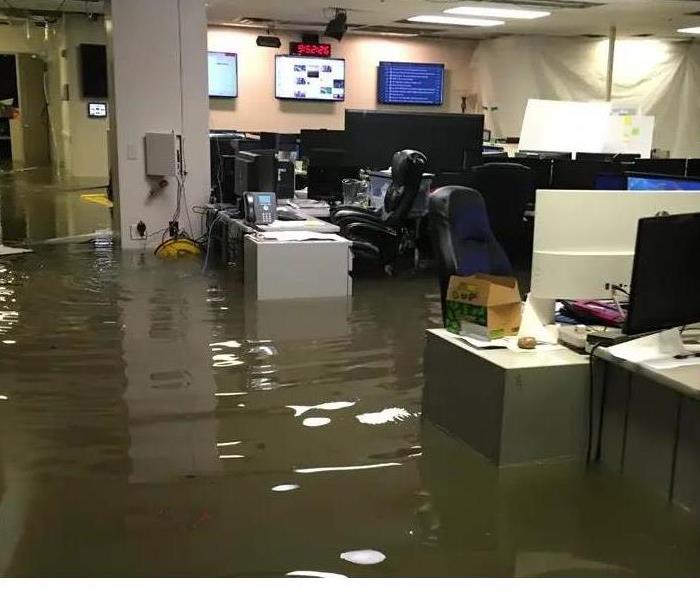 Preparing yourself and your home is important if you live in a flood-susceptible area. Adequate flood safety knowledge can help lessen injury, damage
Preparing yourself and your home is important if you live in a flood-susceptible area. Adequate flood safety knowledge can help lessen injury, damage
While natural disasters are simply out of your control, preparing for a disaster is something you can see to. If you live in an area where floods are possible, there are some things you can do before, during, and after to minimize damage. Here are some safety tips at each stage of a flood.
Before a Flood
Floods are particularly devastating because they happen with little to no notice and can cause significant damage, injuries and even death. Although you can’t prevent this unexpected event, here are some flood safety preparation tips:
- Install non-carpet flooring
- Prepare an updated emergency kit
- Find out where relocation centers are located
- Make sure you have flood insurance
- Store important documents in a waterproof container
During a Flood
If your safety is not in jeopardy and you have time to prepare your home for a flood, you can lessen the amount of damage that occurs. First, move furniture, rugs, electronics, and valuable items to higher ground. Second, make sure you have your important documents either stored in a waterproof case or bring them with you if you’ll be leaving. Other safety tips include listening to the local radio for warnings and instructions, grabbing an emergency kit with essential supplies to take with you, and shutting off all utilities. If possible, empty your fridge and freezer and leave doors open to minimize damage if they float.
After a Flood
Flood safety is paramount to preventing injury and loss. Never let your children play near floodwaters and never attempt to drive into water of unidentified depth. Once it’s safe to return to your home, the best thing you can do to minimize loss or harm is to contact a water damage specialist. If you feel it’s safe to enter your home, exercise extreme caution because walls and ceilings may be compromised. Check for damage and take pictures for insurance claims.
Preparing yourself and your home is important if you live in a flood-susceptible area. Adequate flood safety knowledge can help lessen injury, damage and death.
How To Deal With Winter Storm Damage
12/7/2022 (Permalink)
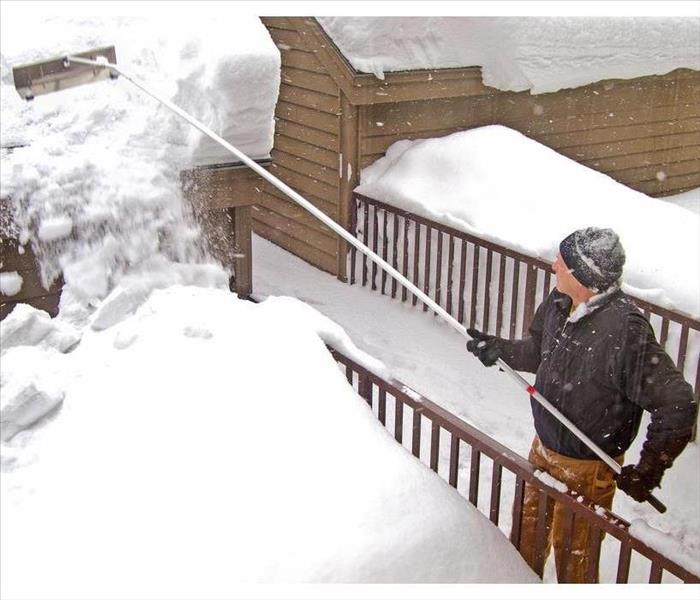 Start by removing all snow and ice from your roof and gutters.
Start by removing all snow and ice from your roof and gutters.
Dealing with Winter Storm Damage
Winter storms can be destructive, but they're also part of normal weather patterns. If you're hit by a winter storm, it's important to know how to deal with the damage as quickly as possible. This guide will help you assess the damage and clean up after a storm so that your home stays safe and protected from further damage.
Don’t Panic
When a storm is over, it's easy to let your emotions get the best of you and cause damage in the process. The key is knowing what steps to take as soon as possible after a storm passes so that you don't make things worse for yourself or your property. If a winter storm has left your home or business in need of repair, don't panic and use these tips for how to deal with winter damage.
Assess the damage
The first thing to do when a storm hits is to inspect your home for structural damage, like the roof being blown off or walls collapsing from high winds. If you have any doubts about the integrity of your house and its ability to withstand further weather-related damage, contact a professional contractor immediately for help assessing the situation. You can also call an insurance agent who can provide advice over the phone as well as assistance with filing claims in case of damage or injury related to winter storms (though keep in mind that most policies don't cover flooding).
The next thing to check for is water leaks. If you find that there's water leaking into your home due to pipes breaking due to freezing temperatures (which happens more often than one might think), then it's time now more than ever before we start acting as our grandparents did: put on slippers and go out there with some towels! Use those towels not only for wiping away puddles but also soaking up excess moisture so that it doesn't freeze overnight leading into tomorrow morning when classes start again after being canceled this past weekend due to all that snowfall yesterday afternoon while everyone else was getting ready
Clean up
Once the storm has passed, you need to clean up. Start by removing all snow and ice from your roof and gutters. This will help prevent further damage to your home. Next, remove any damaged items, such as tree limbs or shingles that have been torn off by high winds. If the item is small enough, you may be able to toss it into a trash bag yourself; otherwise, call in professionals for assistance removing larger items like trees.
Clean up any broken glass that results from windows being blown out or doors being slammed open during high winds—you don't want anyone getting injured! Finally, remove excess water that has accumulated inside of your home. It's essential not only for cleanup but also to avoid mold growth.
Protect Your Property
Winter storms can be a hassle, but there are things you can do to protect your property. First, make sure the power is turned off. Then close all windows and doors, and remove any valuables from the area. If you have a generator, it's best to use it outside.
Winter storms can be extremely damaging, but the worst part is the stress they create. If you find yourself in this situation, it’s important that you take action quickly. By following these steps and contacting SERVPRO of Stillwater & Guthrie immediately, you can get back to enjoying your Guthrie, OK home and life as soon as possible.
Flood Safety Tips for All Stages
7/20/2022 (Permalink)
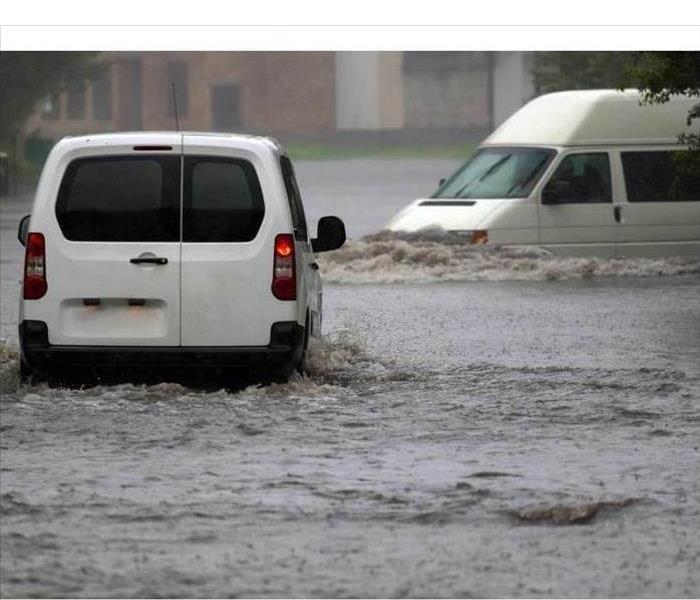 Never attempt to drive into a flooded street
Never attempt to drive into a flooded street
Tips for Flood Safety
While natural disasters are simply out of your control, preparing for a disaster is something you can see to. If you live in an area where floods are possible, there are some things you can do before, during, and after to minimize damage. Here are some safety tips at each stage of a flood.
Before a Flood
Floods are particularly devastating because they happen with little to no notice and can cause significant damage, injuries and even death. Although you can’t prevent this unexpected event, here are some flood safety preparation tips:
- Install non-carpet flooring
- Prepare an updated emergency kit
- Find out where relocation centers are located
- Make sure you have flood insurance
- Store important documents in a waterproof container
During a Flood
If your safety is not in jeopardy and you have time to prepare your home for a flood, you can lessen the amount of damage that occurs. First, move furniture, rugs, electronics, and valuable items to higher ground. Second, make sure you have your important documents either stored in a waterproof case or bring them with you if you’ll be leaving. Other safety tips include listening to the local radio for warnings and instructions, grabbing an emergency kit with essential supplies to take with you, and shutting off all utilities. If possible, empty your fridge and freezer and leave doors open to minimize damage if they float.
After a Flood
Flood safety is paramount to preventing injury and loss. Never let your children play near floodwaters and never attempt to drive into water of unidentified depth. Once it’s safe to return to your Navina, OK, home, the best thing you can do to minimize loss or harm is to contact a water damage specialist. If you feel it’s safe to enter your home, exercise extreme caution because walls and ceilings may be compromised. Check for damage and take pictures for insurance claims.
Preparing yourself and your home is important if you live in a flood-susceptible area. Adequate flood safety knowledge can help lessen injury, damage and death.
How to Meet Flood Cleaning Requirements After a Residential Flood
6/27/2022 (Permalink)
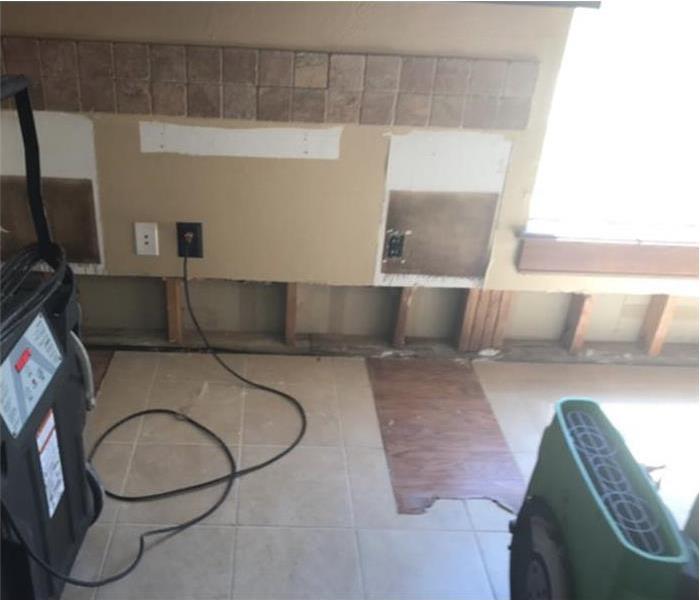 Drying property after water damage in Sumner, OK.
Drying property after water damage in Sumner, OK.
How to Comply with Flood Cleaning Requirements Following a Home Flood
After a residential water incident, the flood cleanup process can feel like a long road. As you seek out cleaning requirements, remember that proper restoration will bring your home back to safety and suitability. Focus on the following essential prerequisites before resuming residence.
Work with an Electrician
Because water can have such a detrimental effect on electric outlets in a home, never begin flood clean-up efforts without the approval of a professional electrician. Hire an electrician to help in the following ways:
- Inform homeowners of downed power lines near sitting water
- Inspect water damage sustained to electrical outlets and fixtures
- Recommend professional cleaning services for electronic appliances
Focus on Drying
Once an electrician clears your home for the pursual of cleaning requirements, the first thing you should focus on is drying. Everything will need thorough drying from the home structure itself to all of the affected goods inside. Take pictures for insurance purposes of items that must be discarded because they are unsalvageable.
Pull back carpets and other flooring surfaces then use fans or fresh air to dry out the sub-flooring. If possible, open windows to create greater airflow throughout the building. If bedding or clothing gets wet in the flood, wash it thoroughly with hot soapy water and dry it on high heat to kill any bacteria.
Tackle Sanitation
At last, when the drying process has been completed, proper cleaning can be done with a few sanitation efforts. Some materials such as soaked wood or upholstery will have got to go. Plush animals and other difficult-to-wash items should also be disposed of. Sanitize all non-porous surfaces to reduce the chances of producing mold. Most surfaces can be sterilized using a heavy-duty flood disinfectant cleaner or a bleach and water solution.
When dealing with a home flood in Sumner, OK, the cleaning process can take time and effort. As you set-out to meet cleaning requirements, make safety and proper restoration the goal of your endeavors.
How Property Managers Can Prepare for Hurricanes
4/25/2022 (Permalink)
 If a mandatory evacuation is put into place, none of your staff should stay on the premises.
If a mandatory evacuation is put into place, none of your staff should stay on the premises.
Preparation Tips for Hurricanes
As a property manager, you have a lot of responsibilities. One of them is storm preparedness. Hurricanes in Sumner, OK, can be particularly dangerous, so you need to make sure your building is ready for excessive rain and winds. Here are some preparation tips.
Contact Information
You should have an emergency contact list for everyone on your property. The list should include:
- Names
- Individuals with special needs
- Email addresses
- Cell and home phone numbers
Documentation
Once the hurricane is over, you will need to file a claim with your insurance company. The insurer can often help you with storm-related expenses, including remediation and cleanup services.
To expedite the claims process, you should take time-stamped videos or photos of your property prior to the storm. The pictures should document the exterior of the premises and any common areas. Store the images off-site or back them up digitally so you can show them to the claims adjuster.
Maintenance
Cleaning the exterior of your property is important for storm preparedness. Before the storm arrives, you should empty the dumpster and secure any large outdoor items. Be sure to trim trees close to the building, as well.
Staff Delegation
As the hurricane approaches, make sure all of your staff members know their responsibilities. Front-desk workers, managers and engineers should remain on-site for as long as possible so they can assist everyone in the building. Once the winds increase, essential employees should work together to mitigate damage to HVAC systems, water pumps and other important equipment.
If a mandatory evacuation is put into place, none of your staff should stay on the premises. Before your employees leave, give them a phone number or email address that they can contact to find out about returning to work. As the property manager, you should be the last person to evacuate the property.
Storm preparedness is a necessary part of property management. The above tips should help you secure your building and keep everyone safe.
The Essential Items To Include in Your Business Emergency Kit
4/6/2022 (Permalink)
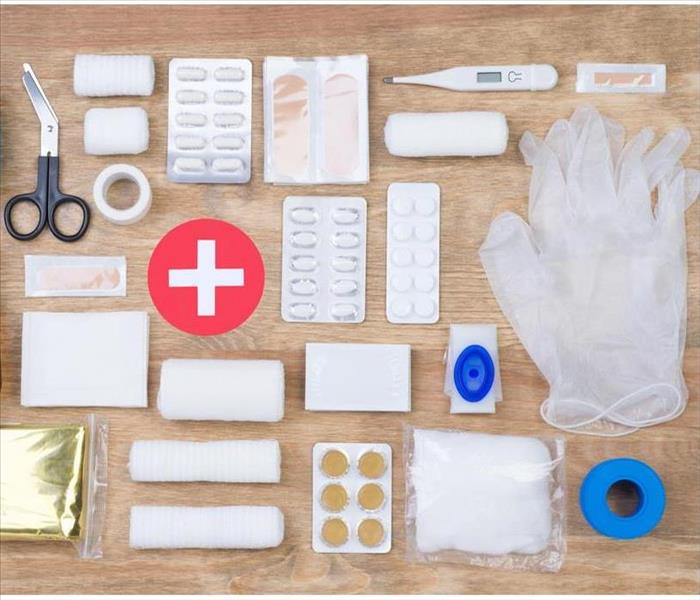 Increase the number of first-aid supplies based on how many employees or patrons are typically present.
Increase the number of first-aid supplies based on how many employees or patrons are typically present.
What To Keep On Hand In Case of a Disaster
In the event of an emergency, a swift response is the most effective way to keep everyone safe. To react quickly, commercial property owners should have an emergency kit stocked with the supplies necessary to avoid danger or to shelter in place until relief arrives. Of course, this should include a basic first aid kit, but what other essential items should be kept in stock? Here is what to keep on hand in case of a disaster.
First-Aid Basics
If a disaster happens in Guthrie, OK, having some basic medical supplies on hand is essential, but what exactly should be in the first aid kit? The Occupational Safety and Health Administration recommends:
- Gauze pads in various sizes
- Adhesive band-aids in multiple sizes
- Wound-cleaning agent
- Splint
- Elastic wraps
- Latex gloves
- Scissors
- Resuscitation equipment
- At least one blanket
- Tweezers
Increase the number of first-aid supplies based on how many employees or patrons are typically present. Make sure to include directions for requesting emergency assistance as well.
Sanitation Items
Be sure to consider sanitation items. Maintain basic hygiene by including things such as hand sanitizer, deodorizers and toilet paper. Keeping disinfectants and hygiene products will maintain sanitary conditions until help arrives.
Comfort Items
Comfort items may not be as top-of-mind as a first aid kit, but they are also essential. Put in extra blankets for warmth and solar chargers to keep electronic devices online. There should also be food and water for the building’s emergency kit. Storm damage could threaten the building’s water supply or leave employees stranded waiting for storm cleanup crews. High-energy and non-perishable foods, such as canned meat and vegetables, will keep everyone nourished and comfortable.
Emergencies are unpredictable. Whether it’s an earthquake, a storm, or a fire, a disaster can strike at any time. Maintaining a well-stocked emergency kit with plenty of supplies will ensure that the building is equipped for the worst.
3 Steps To Take After a Flood
1/11/2022 (Permalink)
 Make sure to turn off the electricity to avoid shocks of fire.
Make sure to turn off the electricity to avoid shocks of fire.
Prevent Further Damage In Your Home After a Flood
Flooding is a common occurrence in residential homes. Whether it’s because of a storm or a pipe burst, homeowners in Navina, OK, should be aware of the challenges that come with water damage. One of the biggest concerns is mold growth. If you have suffered from a flood, here are three steps to take to prevent further damage.
1. Document Everything
After the initial disaster, it’s important to take pictures of the damage. When you contact your insurance, you can use these photos as evidence of the things you lost and the surfaces that were damaged. This can help you get the most out of insurance. After connecting with your insurance agency, they will send out an adjuster within the next few days to assess and confirm the damage.
2. Clean Up the Damage
Letting the floodwater sit will only create more damage and allow mold growth to sprout and spread. Here are a few things you should keep in mind when removing the water:
- Shut off the electricity first
- Wear protective clothing while in the potentially-contaminated water
- Store wet documents and books in the freezer to preserve them
- Throw away food items that were affected by the water
With these tips, you can start to remove the water with a pump or start to air dry the damaged rooms.
3. Call the Professionals
It’s time to call in the restoration specialists to help you remove any additional water and properly dry the rest. They can help you restore your home and salvage valuables. They can help with the mold removal process as well.
Although floods can be disastrous, you can address the aftermath in a calm and smart way. Water damage often leads to mold growth, but you can do what you can to minimize the damage and prevent future mold problems from arising.
Understand the Danger of Flood Waters
11/15/2021 (Permalink)
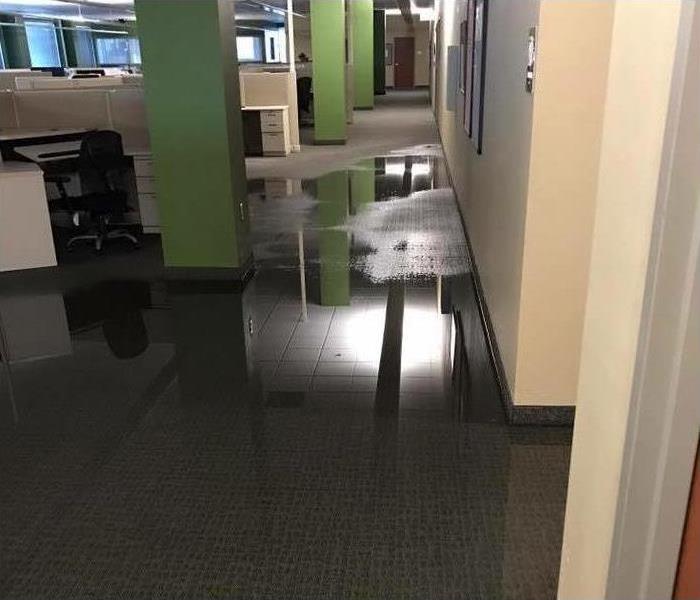 Office flooded in Perry, OK.
Office flooded in Perry, OK.
Flooding brings many dangers with it but when the water rises in Perry, OK, you may be tempted to make the best of a bad situation. After all, who doesn't enjoy a day playing in water? However, in addition to the dangers inherent in cold, racing waters, there are hazards that have to do with contaminants in flood water.
Levels of Flood Contamination
Health authorities provide measures and labels to describe the danger of water from flooding.
• Level I: A small amount of water inside a single building that can be cleaned up before it soaks into building materials
• Level II: Overflow within a single building that covers a much larger section of the interior and soaks into carpeting, drywall, etc.
• Level III: Black water from outside the building with significant damage and flooding
Heavy storms or rains could cause many types of flooding, but when they bring water into your properties, always treat the water as if it were category 3 black water. Take appropriate precautions to protect the health and well-being of your staff and any of your customers or clients.
The Dangers of Black Water
One of the most serious aspects of storm damage is black water. Because of contamination, flood water is a category 3 health hazard. Some of the pollutants in the water include raw sewage, human and animal waste, seepage from septic tanks, chemicals, drainage backflow, and fuels from vehicles. Without knowing where the water has been, it's best to assume that it has been contaminated with very hazardous substances. Avoid all contact with this water.
How to Recover From Contamination
If flood water has risen through your business properties, contact a flood remediation company to address the damages. These professionals have the tools and training necessary to thoroughly clean your premises without leaving any harmful contaminants behind. Instead of trying to DIY this serious issue, turn your focus to keeping your personnel and clients safe.
The 4 Steps of Storm Damage Remediation
9/27/2021 (Permalink)
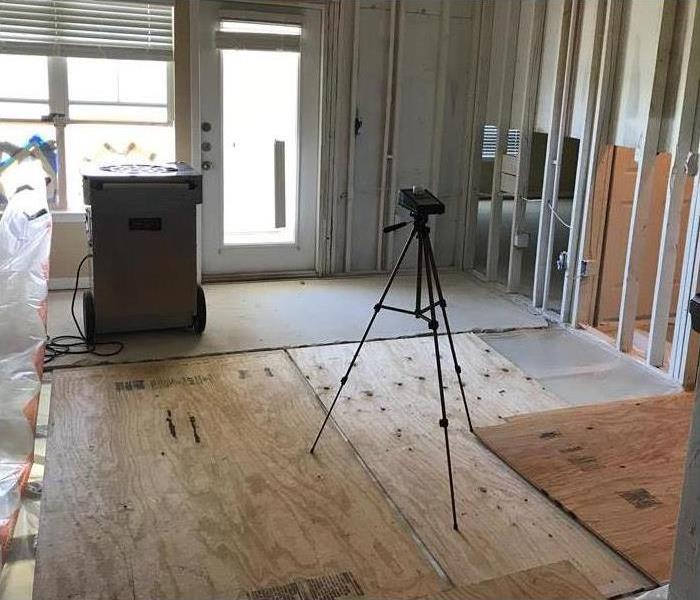 SERVPRO can respond to your home after a severe storm in Perry, OK.
SERVPRO can respond to your home after a severe storm in Perry, OK.
The Four Steps of Storm Damage Repair
Storms can be scary while they're happening. They are loud and they may cause your whole house to shudder with each gust of wind. Another thing that many people find daunting is taking care of the damage the storm left behind. The idea of people coming in to tear out walls and rip up carpet may fill you with stress. By understanding the steps that storm restoration experts take when you hire them to fix your home in Perry, OK, however, you can probably calm some of those fears.
1. Water Extraction
The first thing technicians do is remove the remnants of the flood that caused the water damage to your house. They may use industrial pumps to extract the water from your home in order to reveal the extent of the problems underneath.
2. Material Removal
After all the water is gone, the next step is removing all the materials that the water destroyed. Specialists may have to tear out walls and insulation, basically gutting the area the flood affected. This part of the process may seem extreme, but it's better to replace a ruined wall than ignore it.
3. Structure Drying
While the large volume of water in the area is long gone, the damp surfaces and any water that's hiding in a secret corner still need to be addressed. Leaving the surface of the counters and cabinets wet throws out the welcome mat to mold.
4. Home Restoration
Mitigating the damage caused by the flood is commendable, but without full restoration of the area's aesthetic and function, the job isn't quite done. If they have to remove portions of the wall, restoration specialists will replace the wall and make sure that the wall paper or paint job matches consistently.
Knowing what will happen during the mitigation process can answer some of your questions and calm your nerves. The specialists you hire should also sit down with you and walk you through the process before beginning.
Best Ways to Clean Your Belongings After a Flood
7/29/2021 (Permalink)
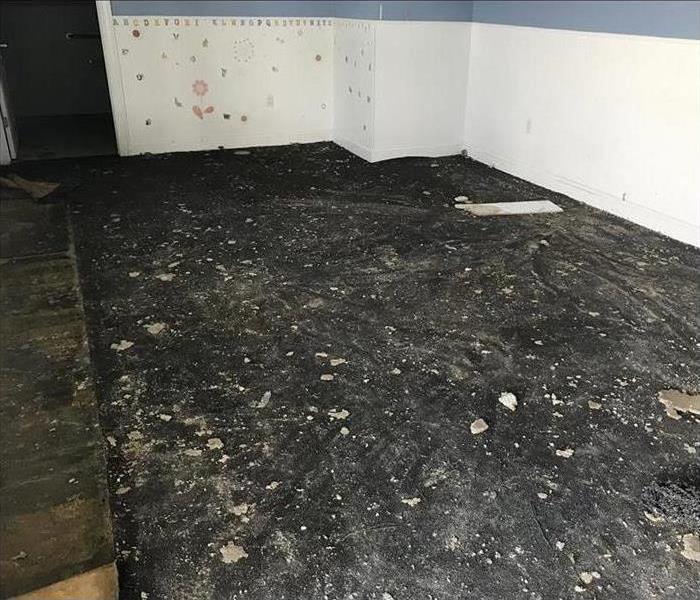 Damaged flooring after a storm.
Damaged flooring after a storm.
Content Cleaning After Water Damage
Watching a disaster such as a flood come through your Cele, TX, home is a helpless, heartbreaking feeling. In most cases, there is little you can do once the incident is in full force. Luckily, in many cases, you can salvage your most important belongings and essential parts of your house, as long as you use effective content cleaning measures.
Flooring
If you’re dealing with a flood in your home, you may have to replace your carpet or flooring altogether. However, in some cases where the flooding isn’t as bad, you may be able to keep your flooring with heavy-duty cleaning.
• Use high-pressure steam cleaning to clean carpets
• A wet vacuum can suck up water from hard surfaces
• Sanitize after removing water
• Make sure you thoroughly dry the area after you clean
Books and Documents
In a flood, you’ll be concerned about important documents and books. Restoration professionals have state-of-the-art measures to not only clean these items but make them look as close to new as possible. The technician will use methods such as vacuum freeze-drying and gamma irradiation to remove water. It’s also vital that the technician dries these items thoroughly. A professional can work with items such as photographs, x-rays, paper and parchment.
Porous vs. Non-Porous
Part of content cleaning includes assessing what you can save and what you must part with. Unfortunately, not even the best methods can save everything all of the time, especially if the flooding introduced black water into your home. It’s more difficult to clean and save porous items such as wood than it is to handle non-porous materials such as glass.
When you need an expert solution to your content cleaning needs after water damages parts of your home and belongings, make sure you find a company that can use these effective measures. You can rest easy knowing not everything will be a lost cause after a flood.
How To Prepare Your Building For a Storm
5/26/2021 (Permalink)
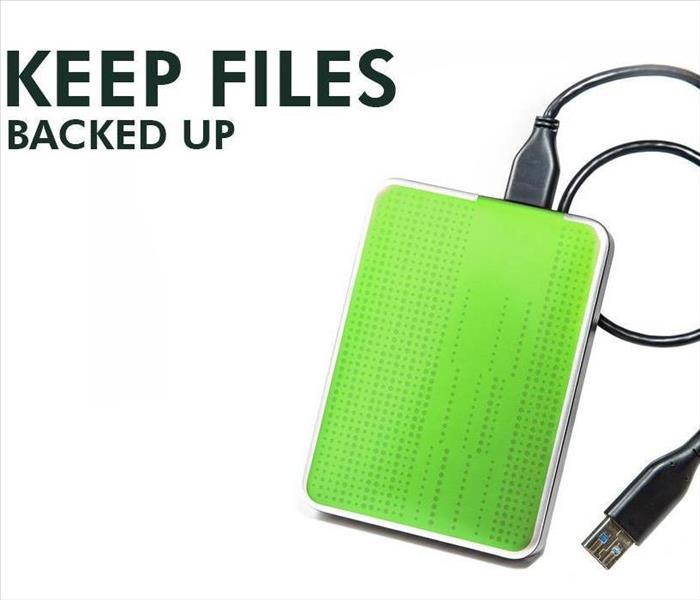 Keep computer files backed up on an external hard drive or cloud in case of fire damage.
Keep computer files backed up on an external hard drive or cloud in case of fire damage.
Storm Preparation Tips
If a storm is approaching in Stillwater, OK, you may be worried about your commercial building and preparing for damages from the storm. Although many are prepared for storm damage like flood water in their homes, it's also important for building owners to ensure that their building can withstand a storm. Whether you're just looking to gain some extra knowledge or are preparing a storm emergency plan, these storm preparation tips can help you stay safe in the event of a storm.
Take Time To Assess Your Property
It's important to inspect your building prior to a storm approaching to ensure that it can withstand high winds, hail or other damaging weather. During your assessment, you can make sure that:
- All shutters are on windows in case of high wind
- Any furniture that could be impacted by flood water is removed
- Large branches or trees that could potentially fall on your building during a storm are removed
- Your building has had a recent roof inspection and no repairs or upgrades need to be made
You may want to take note of the strengths and weaknesses of your building, and address any weaknesses that could potentially damage your building. For example,
Put Documents in a Safe Place
All buildings have some types of important documents that need to be kept safe and dry, such as legal documents, building inspections, financial documents and tax information. A flooded building can destroy documents in just a few seconds, so it's important to locate these documents and move them to a safe, dry space. If important information is kept digitally, back up an external hard drive and keep it off-site or to an upper level in case of flood water damage.
Although these storm preparation tips can help prepare your building for a flood, hurricane or storm, your building may still need repairs after a big storm. After a storm, call in a storm damage company to help you with the restoration process.
3 Tips for Handling a Company-Wide Snow Day
4/10/2021 (Permalink)
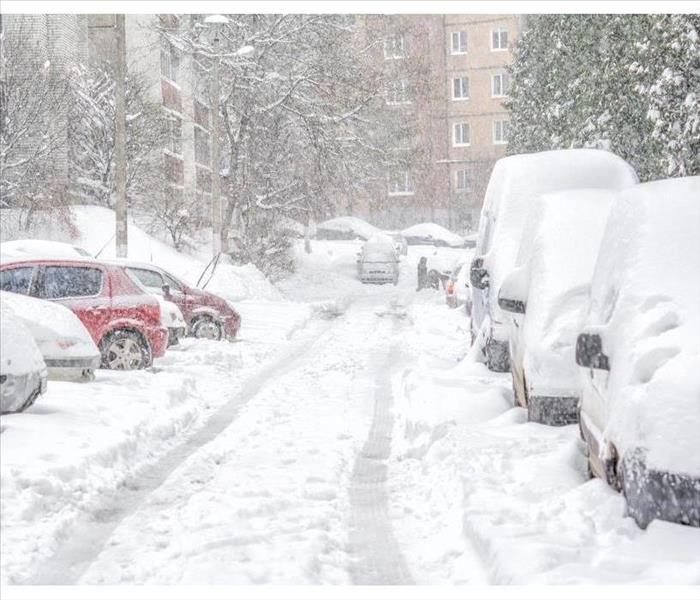 Snow storm season won't last forever.
Snow storm season won't last forever.
Three Tips For Handling Inclement Weather
As a business owner in Perry, OK, you know a snow storm can roll in unexpectedly in a matter of hours. For your employees, commuting in harsh weather conditions can be both dangerous and inconvenient. Consider the following three tips for handling inclement weather days at your local business.
1. Create a Snow Day Plan in Advance
To get the results you desire, planning ahead of time is the best way to ensure success. Create an inclement weather plan and distribute it to all employees as soon as possible. Determine how your employees will be contacted in case of a workday delay or cancelation due to a snow storm. Designate workers who are essential on-site, and those who can work from home. If weather reports show a storm is coming, review your policies with employees to give them a heads-up.
Implementing a weather-related work delay can be beneficial:
- Show your employees that you care about their safety
- Lower operation costs by closing facilities for the day
- Bolster at-home productivity for employees who can work remotely
2. Prevent Weather-Induced Emergencies
Along with severe storms can come freezing cold. If local news stations predict falling temperatures, protect your facilities from potential weather-related damage. Ensure all equipment is safely put away in weather-proof storage. Maintain temperatures above 55 degrees inside your buildings to prevent a pipe burst or freeze incident. Keep your facilities safe from winter storms, or you may need to contact an after-storm cleanup service.
3. Stick to Your Decision
Once you create a protocol for handling a storm, be consistent and follow through so your employees know they can count on you. If bad weather is looming, make the call for a snow day and stick with it.
Snow storm season won't last forever. Make sure you're prepared, so your business and employees can weather the winter with a minimum of trouble.
Avoid These 4 Things After a Home Flood
1/14/2021 (Permalink)
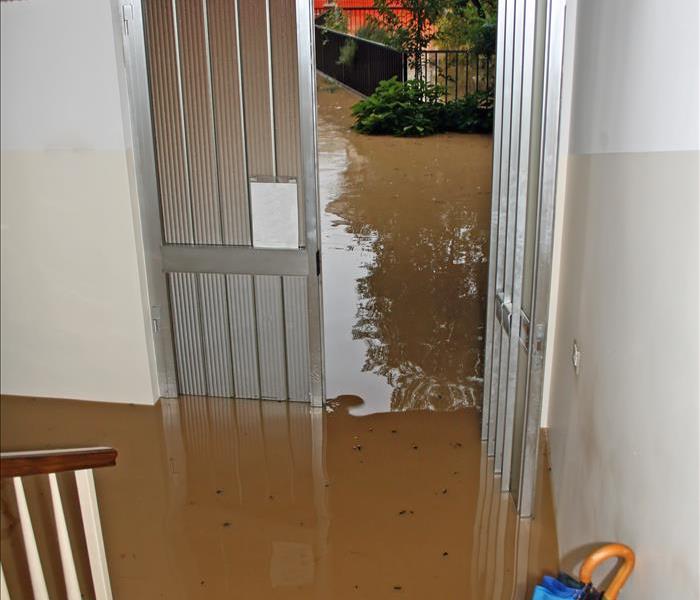 Flood damage to a home in Perry, OK
Flood damage to a home in Perry, OK
When lakes, rivers, and sewers overflow into a home, the flood water brings more than moisture into a residence. The fluid harbors high levels of bacteria and microbes, making the dampness a structural hazard. Homeowners should be careful upon reentrance, taking great care to avoid certain things.
The Following are Four Things Not To Do
1. Resume Residence
Blackwater is not safe for others to be around. That means until everything is cleaned up and assessed properly, owners should reside in an alternate location. Make plans to stay with friends, neighbors or a hotel.
2. Handle Items With Bare Hands
A flooded home hosts organisms that should not come into contact with human skin. Seek professional assistance to examine the location, and if you do go inside be sure to wear protective gear such as gloves and rubber knee-high boots.
Experts are likely to wear clothing designed to safeguard them; plus, they may create a barrier among rooms that are safe versus contaminated.
3. Use Household Cleaners
Flood water absorbs quickly into porous materials. That means that carpets, drywall, and possessions could be polluted. Soap and other cleaners such as bleach do guarantee internal cleaning; therefore, it’s best to remove anything saturated from the premises.
4. Allow Premises to Dry Naturally
While water damage may seem innocent enough, it’s quite problematic. When left alone, it leads to secondary issues such as mold and mildew. Appropriate and immediate action should be taken to dry out the rooms using the right equipment. Industrial dehumidifiers extract humidity from the air and the walls. Moisture readers determine if spots are in the correct zones. Rely on these tools.
If a home is harmed by floodwater, homeowners should jump into action; however, that doesn’t necessarily mean grabbing a sponge and chemical bottle. Work with a water remediation team in Perry, OK, to handle the exposure in the right manner.
6 OSHA First-Aid Best Practices
11/16/2020 (Permalink)
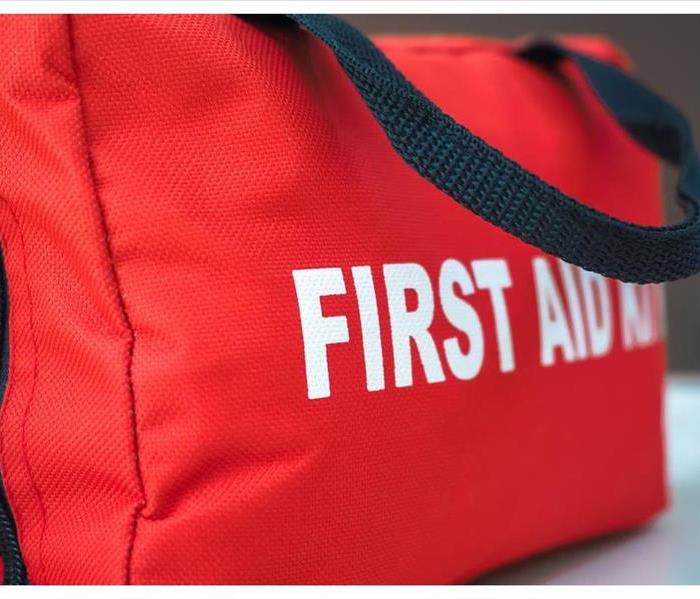 OSHA requires at least one first aid kit at every workplace
OSHA requires at least one first aid kit at every workplace
Maintain A Safe Work Environment
Emergencies don’t announce themselves pre-arrival. Make sure that your worksite(s) in Perry, OK, are adequately equipped well in advance. Accidents can happen in any environment. Therefore, the Occupational Safety and Health Administration requires at least one first aid kit at every workplace (the type and quantity depend on specific hazards and the number of employees). OSHA offers some best practices for employers to maintain a safe work environment.
1. Assess Risks
To sufficiently stock the kit, you should conduct a risk assessment for your worksite(s). Once this is complete, your first aid program should have plenty of supplies should a crisis occur.
2. Choose Relevant Supplies
After the risk assessment, you’ll have a better understanding of the likelihood of certain types of injuries occurring. This will help determine if there are more specific supplies you should keep on hand in addition to the basics.
3. Make Supplies Accessible
OSHA requires that a fully-stocked emergency kit remains easily accessible. Everyone needs to know where to find these supplies. Place each first aid kit and related emergency information in a conspicuous place that any employee can access at a moment’s notice.
4. Provide Training
First aid supplies aren’t very beneficial if people don't have the knowledge or confidence to use them correctly. First aid training should be offered to all employees. It should also include some items specific to your industry if extraordinary job hazards exist. You should periodically update this information and training, as it’s easy to forget some aspects or overlook essential safety updates.
5. Designate a Director
Designate someone to organize contingency plans for disasters such as workplace accidents, storm damage, fire or flood. They’ll be in charge of stocking and maintaining first aid supplies and other emergency equipment. It’s also critical that they stay updated on OSHA regulations. A list of emergency contacts such as emergency restoration professionals should be posted.
6. Review
The first-aid leader should monitor overall workplace safety and potential hazards. Emergency policies, equipment, supplies and training should be modified as necessary.
An emergency can arise at any time. It’s critical to keep a first aid kit available and a plan in place.
How To Prevent Mold After a Flood
10/21/2020 (Permalink)
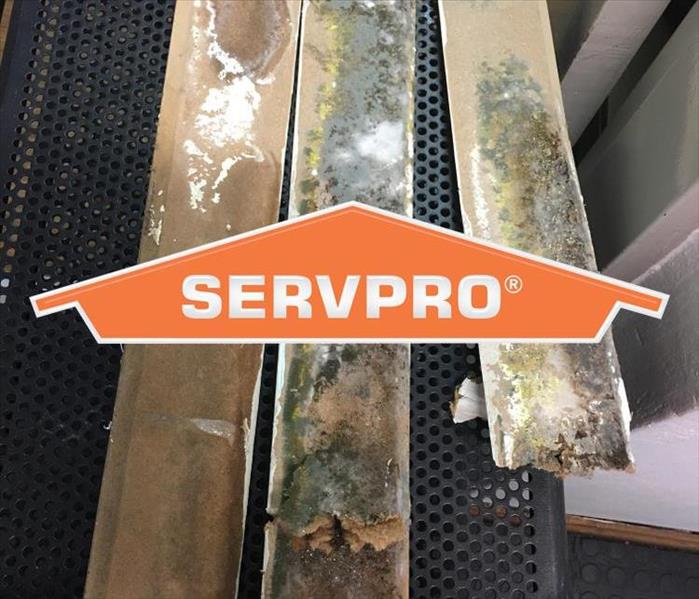 Mold growth happens fastest on porous surfaces such drywall
Mold growth happens fastest on porous surfaces such drywall
Tips To Avoid Mold After A Flood
If you experience flooding in your home in Perry, OK, it's important to take steps to prevent mold growth. It can take only two or three days for mold to spread throughout your home, so making sure you prevent it is vital. Here are some tips to help you avoid mold after a flood.
1. Dry the Area Thoroughly and Quickly
Once you find the flooding, it's important to dry your home as quickly as possible. After you remove the majority of the water, set up fans and dehumidifiers to help fully dry the area out. Keep these running much longer than you think you need to in order to fully remove the moisture.
2. Focus on Porous Items
Mold growth happens fastest on porous surfaces such as carpet and drywall. If any of these materials got wet in the flood, make sure you quickly and thoroughly dry them or just remove them altogether. Check to make sure your carpet pad and the floor beneath it is throughly dried as well. If your drywall is wet, you'll probably need to replace it, especially since the water can get into the insulation and cause mold to grow there.
3. Keep Checking the Area
After you remove all the water, make sure you pay attention to any musty smells coming from the damaged area in the future. This often is a telltale sign that you have mold and that it's time to call a mold removal company. Keep from disturbing the area as much as possible so that you don't spread it throughout the rest of the house, and call the professionals as soon as you can to prevent it from becoming a much larger problem.
After you clean up the water damage in your home, remember to take steps to prevent mold growth as well. Follow these tips and be ready to call a professional, and you'll be able to prevent more harm to your home.
Making Sure Your Company is Disaster Prepared
9/14/2020 (Permalink)
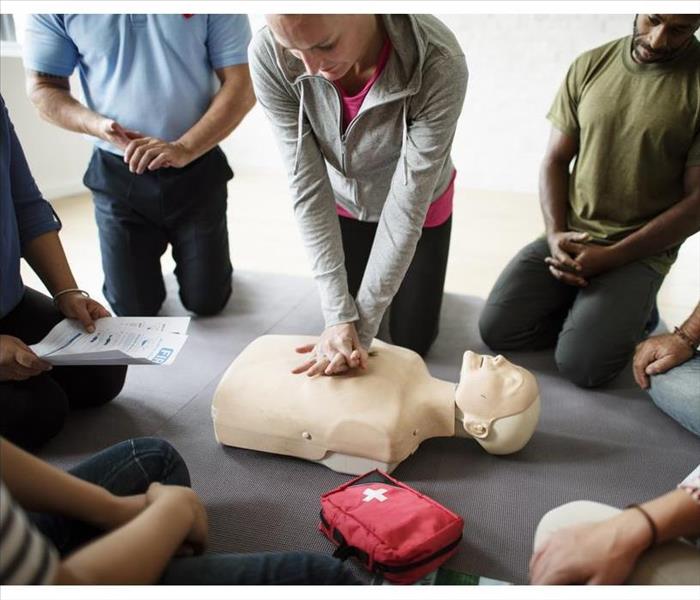 Offer courses in first aid and CPR
Offer courses in first aid and CPR
Disasters come in many forms and not being prepared for them can make business recovery slower. Disaster preparedness in Stillwater, OK, should be a staple in the operations of your business. Disaster and business preparedness means your business can bounce back more quickly to help keep the economy strong.
Disasters That Can Happen at Your Business
There are many important areas for disaster preparedness. The type of proactive measures your business takes will largely depend on the industry. Some disaster precautions that are useful to all businesses include
- Fire safety
- Medical emergencies
- Tornado Warnings
- Evacuation plans
Some businesses operate with toxic materials or may need increased cyber security. Have a plan for what action to take in the case contaminants are released into the air or someone hacks into your system.
Caring for Employees
During a disaster, medical emergencies can happen. Make sure your employees know where to find the first-aid kit, and offer courses in first aid and CPR. While an employee is not required to disclose any medical condition they may have to their employer, encouraging them to do so may help other employees understand an issue they are facing in an emergency.
When Disaster Strikes
In the event that a disaster occurs your employees will know the safest part of the facility because you prepared a disaster plan. If a tornado is about to strike, you will have identified a central location without windows where employees can take cover. If there is toxic danger and an area needs to be sealed off, employees will know where to gather so everyone can be accounted for.
After a disaster does occur, never attempt to clean the disaster yourself. The environment could be hazardous, such as electric lines down, or mold present after flooding. Hire a team that is trained to handle this type of clean up.
Having a disaster preparedness plan in place for each of these situations can help employees make critical decisions more quickly, and can also help keep them safe. Start yours today.
Mitigating the Damage From a Storm
8/11/2020 (Permalink)
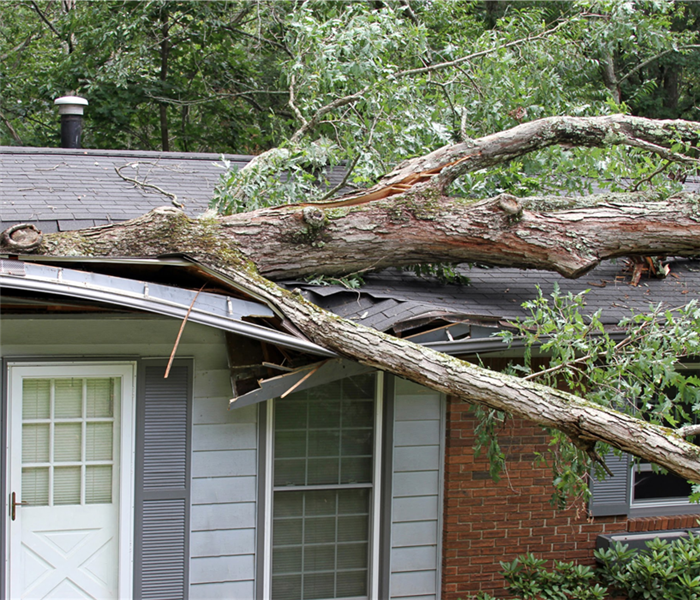 Fallen tree damage in Navina, OK
Fallen tree damage in Navina, OK
Ways To Mitigate Wind Damage
Many homeowner's insurance policies will require that you mitigate any damage to your Navina, OK, home after a storm. This means that it is your responsibility to take measures to prevent any further damage to your home after a severe storm. Here are several ways you can mitigate any wind damage until storm restoration professionals can get to your home.
1. Broken Skylight or Windows
If you have holes in your skylights or windows from flying objects during the storm, you should cover them with a sheet of plastic. This will prevent any water from entering your home and causing more damage to its interior.
2. Leaks in the Roof
When your roof starts leaking due to a storm, you need to cover any areas with damaged, loose, or missing boards with a tarp immediately. If it is still raining outside or you cannot get onto your roof for another reason, you should put buckets underneath the leaks to prevent any further water damage to your home. Remember to have a contractor out to fix your roof damage as soon as possible, otherwise, water can enter and cause issues with your home's structure. Your insurance company will almost always reimburse you for this expense.
3. Damaged Siding
Damaged siding is another reason to break out your tarp. If you notice any damaged, loose, or missing pieces of siding, cover them with a tarp immediately to prevent further damage to the interior of your home. Like roof damage, issues with your siding can lead to problems with the structure of your home.
4. Fallen Tree Damage
If a tree has fallen on your home, the first step is to have it removed immediately. Then, tarp the damaged area to prevent water from entering your house and causing further issues.
To keep your home safe from further damage after a storm, you will need to cover most issues with plastic or a tarp until qualified personnel can get to the scene. Whether it is severe roof damage or a broken skylight, covering the issue will prevent water from entering your home and causing structural problems.
Avoid Mold After a Flood
7/28/2020 (Permalink)
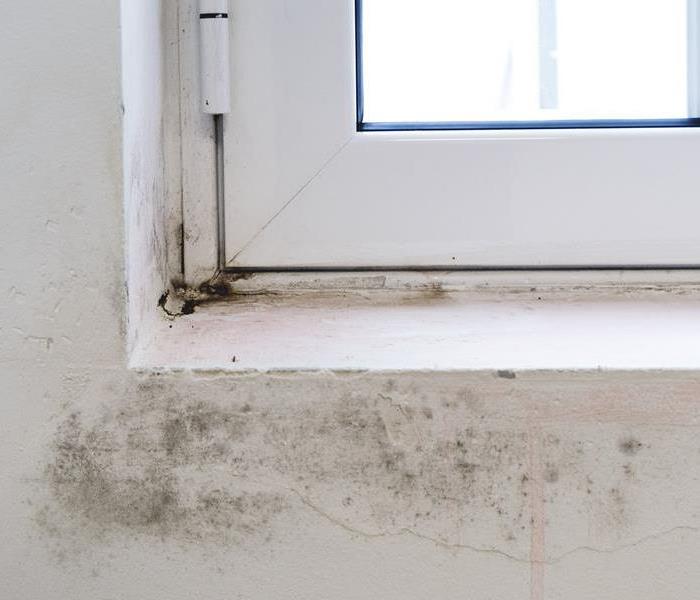 Although mold growth may not immediately come to mind after unwanted water enters the home, it needs to move up the priority list.
Although mold growth may not immediately come to mind after unwanted water enters the home, it needs to move up the priority list.
If dealing with flooding in your Stillwater, OK, home, the number of things to worry about seems to be endless. Alongside the water damage, insurance claims, and destruction of personal belongings, there is another concern that needs immediate action: mold growth. Floodwaters in a home with organic material and warm temperatures produce the perfect environment for this fungus to flourish, and it does so quickly.
A Fast Grower
Mold is actually everywhere, it is just usually lying dormant waiting for the right conditions to flourish. Once that comes together, the timeline for an infestation is rapid.
Most types of mold can germinate within 24 hours. Although still microscopic, the tiny spores can begin to spread to other areas.
If the spores have not been detected within 12 days, they have likely already started to colonize without being visible.
After 18 days, clear signs of mold can be seen.
Prevention Tips
Once mold growth starts to happen, the spores can easily be spread via clothes, air ducts and other means. If that happens, the mold removal process can be quite complex and will require a mold damage remediation and restoration expert to restore a home to normal. Anytime water enters the home, preventing mold growth should be a priority. Prevention tips include:
If outdoor humidity levels are low, open windows to generate airflow.
Remove saturated items to dry out.
Dispose of porous materials that can’t be cleaned.
Use a wet/dry vacuum to clean up standing water on hard floors and carpeting.
Run fans and dehumidifiers to circulate air and contain evaporation.
Clean and sanitize all surfaces that have come in contact with water.
Although mold growth may not immediately come to mind after unwanted water enters the home, it needs to move up the priority list. Taking measures to reduce a welcoming fungus environment can minimize further damage and help your home get back to normal faster.
What To Do After a Flood in Your Building
7/9/2020 (Permalink)
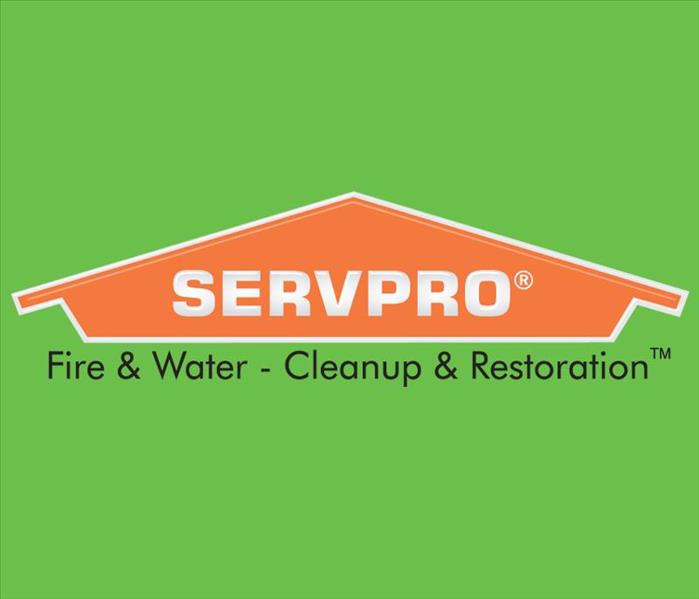 Water damage can be costly, but if you follow these steps, you can prevent many serious issues.
Water damage can be costly, but if you follow these steps, you can prevent many serious issues.
It doesn't take much water to cause problems in your office. Some water damage can start and persist without you even knowing it. You may not be able to salvage everything in your building or prevent all water-related issues. However, with prompt, decisive action, you can minimize the problems and effectively clean up the mess and recover.
Safety First
Your first responsibility after a flood is the welfare of everyone in your office. Before you begin the water cleanup process, take these following steps:
Get everyone in your building away from any standing water.
Find the source of the flooding and stop it, if possible.
Turn off the power to your building.
Save What You Can
Move any items away from the water and get them to higher ground. This should include belongings such as furniture, documents, and clothing. You can pull up wet carpet and leave it out to dry. Even items with water damage can be salvaged.
Call the Professionals
Minimal damage from a slow leak may not be a big concern, but widespread flooding from broken pipes requires the expertise of a professional flood remediation team. technicians have the skills and tools to not only remove the water from your facility but to clean and dry wet items and rebuild damaged materials. The professionals also have the equipment and tactics to safely and quickly restore your office.
Contact Your Insurance Company
Though property insurance policies in Stillwater, OK, don't cover flooding from backed-up sewers or overflowing waterways, you can get help if the flooding is due to other factors. As soon as possible after the incident, call your insurance agent and discuss your flood. Provide as many details as possible, including what was damaged and how the flood began.
Water damage can be costly, but if you follow these steps, you can prevent many serious issues. With the right help, you can effectively clean up your business property.
What Goes in the Commercial First Aid Kit?
7/8/2020 (Permalink)
What Should You Have In The First Aid Kit For Your Commercial Building?
The following list of supplies is the minimum required by Occupational Safety and Health Standards.
- Gauze pads that measure at least 4 x 4 inches and two large gauze pads that are at least 8 x 10 inches. One packed gauze roller bandage that is at least two inches wide.
- A box of adhesive bandages is required for small scrapes and punctures.
- Two triangular bandages, sometimes known as cravat bandages, are used with safety pins to function as a sling or as head wraps.
- Your first aid kit should include a splint that's appropriate for securing broken bones. Include padding to keep the injury stable.
- Adhesive tape, scissors, and two elastic wraps provide an additional layer of security for treating wounds.
- Put at least one blanket in your emergency kit.
- Agents for cleaning wounds, such as packaged moistened towelettes, are crucial for keeping wounds and injuries from developing infections.
- Latex gloves, pocket masks, and tweezers are used to prevent contamination when injuries are treated.
- Include resuscitation equipment such as resuscitation bags and airway masks.
- Provide directions for obtaining emergency assistance. You may want to laminate this page, so it isn't affected by moisture.
If you have a large property or multiple business sites, provide enough kits to cover the area. OSHA recommends that each emergency kit is outfitted for about two to three employees.
Beyond the Basics
Each area of the country is affected by different risks. Flooding may be a major concern for one community while violent crime is a top priority for other areas. Work closely with Stillwater, OK, storm cleanup and remediation professionals to determine additional items to include in your kit.
Just for Emergencies
Hopefully, neither you nor your employees should ever have to use a first aid kit while on your commercial properties. However, if an emergency or injury were to call for those supplies, you'll be glad to have the items on hand.
3 Steps To Mitigate Roof Damage To Your Home
4/28/2020 (Permalink)
 It’s a good idea to pay attention to what the weather is doing in your area
It’s a good idea to pay attention to what the weather is doing in your area
Consider These Three Steps
When you live in an area such as Sumner, OK, you may be worried about the local weather causing roof damage to your home. Fortunately, a storm damage restoration service can help with any repair needs you may have. However, there are a few things you can do beforehand to mitigate potential problems. Next time there’s a storm in your area consider these three things.
1. Pay Attention To the Weather
It’s a good idea to pay attention to what the weather is doing in your area. This will help you have time to prepare properly before a storm occurs. If you’re expecting heavy wind or rain you can take steps such as covering over areas of your roof that may be prone to damage with tarps or boards until a professional can make repairs. You may also want to check for debris or loose gutters that could also be knocked around by the weather and damage your roof.
2. Clean Out Your Gutters
You may also want to take the time to clean out your gutters as this also can help prevent roof damage to your home. Debris such as sticks or leaves can clog the gutter and lead to water backup. This water can then overflow onto the roof and cause problems. When the gutters are clean and the downspouts pointed away from the building, this potential issue is much less likely to occur.
3. Trim Back Overhanging Trees
Another way to help mitigate wind damage to your home’s roof is to trim back any trees that might overhang. Look for weak or dead branches that could be knocked loose by the wind. During a storm, these have the potential to fall on the roof causing damage. Taking the time to remove them beforehand may help mitigate the problem.
If you’re trying to mitigate storm caused roof damage to your home you may want to consider keeping an eye on the weather, keeping your gutters clear of debris and taking the time to trim back any overhanging trees. If damage does occur, a restoration service can help with any clean up and repair needs.
Prevent Mold Damage After Flooding
4/3/2020 (Permalink)
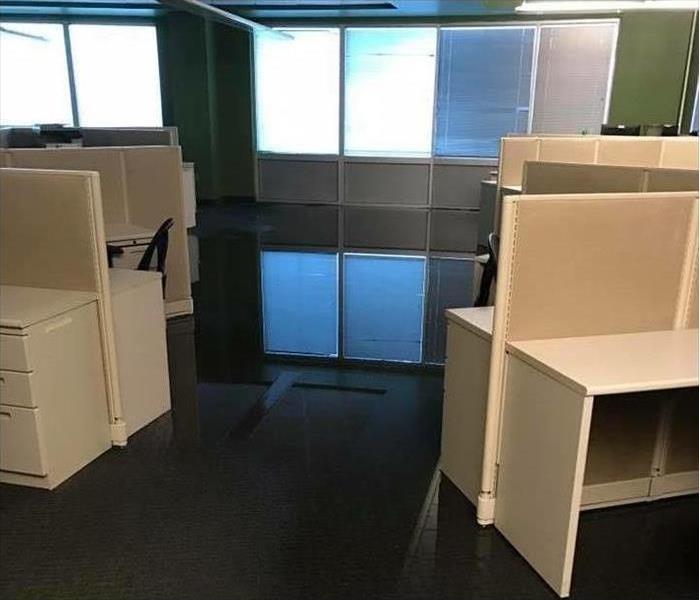 Standing water after storm damage in a Stillwater, OK office
Standing water after storm damage in a Stillwater, OK office
Floodwaters, leaks following major storms, and any other type of water that seeps into your building can lead to a risk of mold growth. Unfortunately, contaminated water also carries bacteria, hazardous chemicals, and potential toxins. Even after you've successfully removed all floodwater from your property, there's still a risk that mold or mildew will set in.
Assess Dangers First
As soon as you notice flooding or standing water, be sure to address any potential dangers:
- Damages to the foundation and floors
- Wiring and live electrical systems
- Gas leaks and damaged piping
- Contaminated water
For your safety, don't work alone. Turn off the water, gas, and electricity. Be sure to contact the appropriate professionals for dangerous hazards, such as black water.
Identify Furnishings and Content To Replace
There are many items in buildings that could hold onto moisture and support mold growth long after the initial emergency is over. Some furniture can't be cleaned sufficiently to prevent the spread of mold, such as pillows and thick cushions. Most water damage cleanup professionals recommend replacing carpeting and the padding below to prevent lingering odors, carpet stains, and mold.
Carefully inspect books and papers for water damage. There are professional services that may save these damaged items, but this can quickly become very expensive. It may be best for most of those items to be replaced.
Prevent the Spread of Mold Spores
Mold spores often hide out in and travel through heating and air conditioning systems. It's best not to run the HVAC system until professionals have inspected and cleaned the ducts. Some components of the system, such as filters, must be replaced before the system runs again. If the HVAC system hasn't been affected by the flooding, it will pick up mold spores and become contaminated if you run it before your property is thoroughly cleaned.
Act Quickly To Prevent Further Damages
Even a tiny amount of mold growth can lead to a lot of damage. Any time your Stillwater, OK, property is affected by standing water, leaks, or flooding, the first 24-hours are crucial in preventing damage. Take cleanup and preventative action immediately.
What You Need To Know About Mold Growth After a Flood
10/26/2019 (Permalink)
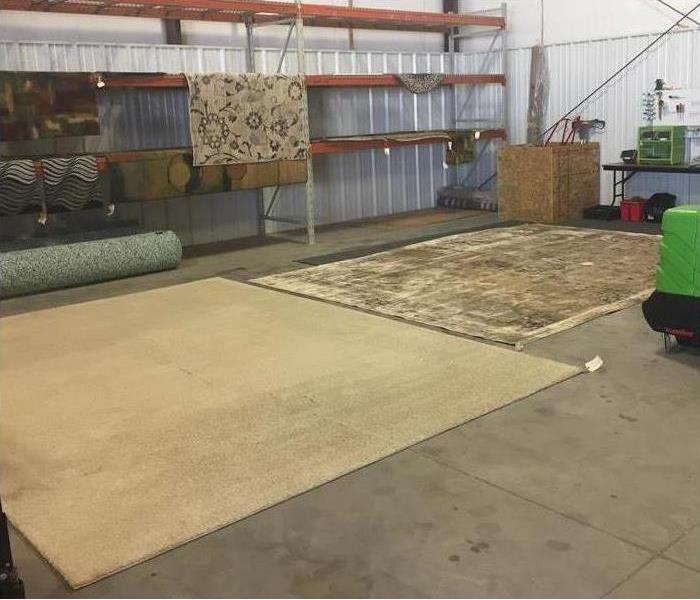 Mold on flooring rugs in Stillwater, OK
Mold on flooring rugs in Stillwater, OK
Mold Growth After a Flood
If your building has been affected by a flood in Stillwater, OK, then you will probably have a lot of damage to deal with afterward. One type of secondary damage that you may notice is mold growth. This is a common problem that occurs after water damage, and the following information may help you handle it properly.
1. Why Does Mold Grow After a Flood?
Flood water can bring bacteria and contaminants, including mold spores, into your building which can contribute to the growth. However, mold will begin to form after any kind of water damage, including that from clean sources. This is because mold lives in most environments, but it needs moisture to grow. Once it has that, it will begin to spread.
2. How Can You Prevent It?
The best thing you can do to prevent the growth of mold is to remove as much moisture from the building as you can. If there is standing water, mold will begin to form within a day or two. Once the water has been removed, dry the building thoroughly. Keeping doors and windows open can help speed up the process. Fans and dehumidifiers are great for this as well.
3. What Do You Do if It Has Already Started Growing?
It is important to dry the building quickly even if mold growth has already formed. However, in this case, the use of items that increase air circulation can end up spreading the fungus throughout the building, so this should be avoided. Protective gear should be worn while the mold is being removed, and the area should be contained to prevent the spores from moving to other areas.
If there is mold growth in your building, you should avoid trying to remove it on your own and instead hire a professional. A cleanup and restoration service can remove the fungus safely and thoroughly without spreading it further. They can also make other necessary repairs to the building as well.
How To Protect Your Building From a Storm
9/10/2019 (Permalink)
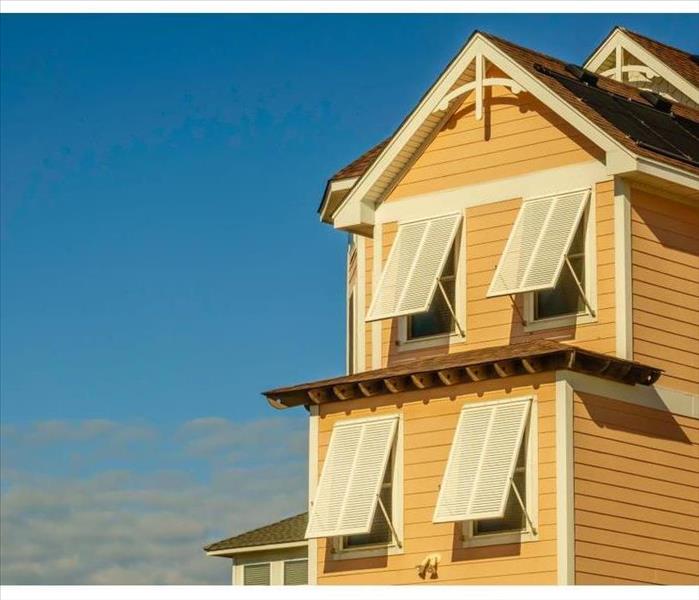 You can purchase special protective shutters
You can purchase special protective shutters
Hurricanes and tornadoes have grown more intense and more frequent in recent years. As a result, preventing storm damage has become a major part of residential facility management.
While you can't stop the storms themselves, you can take steps to protect your buildings. Here are some tips for limiting the destruction of your Ceres, OK, property.
Do Your Research
The best way to get your building ready for a storm is to know what you are up against. The Federal Emergency Management Agency, in particular, has plenty of resources for building owners and managers. FEMA even has special software that can estimate the economic, social and physical consequences of an impending disaster.
Strengthen Your Building
Fortifying windows is an easy way to limit storm damage to property. You can purchase shatter-resistant windows or opt for special protective shutters. A safe room and steel doors are also forms of building protection. You should also pick up any trashcans or loose branches, as the wind could blow theses items into your property.
Plan Ahead
You should create and train a crisis-management team in advance. Team members should practice evacuation drills ahead of the storm. They should also help you prepare a disaster supply kit. You should additionally research emergency restoration services.
Follow the Forecast
After the building is fortified, you need to pay attention to the weather forecast so you can find out exactly when the storm will hit. While you will likely have plenty of time to prepare for a hurricane, you may only get a 15-minute warning when a tornado is heading your way. A battery-operated weather radio, however, can give you the latest updates.
You may also want to sign up for text or email weather alerts from your local television station. Once the hurricane or tornado arrives, stay safe and take solace in the fact that you have done all you can to limit storm damage.
Dealing With Mold in the Home
7/9/2019 (Permalink)
 Ensure household humidity remains below 45% to avoid mold growth
Ensure household humidity remains below 45% to avoid mold growth
Mold growth in Navina, OK, can be a serious problem, particularly after flooding. Therefore, it is important to take proper precautions and address any mold occurrences as quickly as possible.
Causes of Mold
Mold spores are a natural part of our environment and are present almost everywhere. These invisible particles are generally harmless; however, when they make contact with a water source, the mold can grow quickly and take over large areas. This is when mold becomes problematic. The following are common causes of mold in homes:
- Flooding
- Roof leaks
- High humidity
- Plumbing leaks
- Damp bathrooms
Preventing Mold
Mold growth can spread very quickly, so it is important to address any potential problems before they become serious. Ensure household humidity remains below 45%. Certain high-humidity areas, such as bathrooms, may need frequent “airing out.” In these rooms, open a door or window and turn on a fan if needed. Repair leaks and clean up standing water quickly. Tend to water damage from flooding as soon as possible.
Mold Remediation Process
Because mold is present everywhere, complete mold removal is not possible. Mold remediation, however, is a process that removes excessive mold. Water helps mold to grow, so the first step of mold remediation is to address the water source. Next, both the mold on surfaces and spores in the air must be contained. When possible, antifungal and antimicrobial solutions are then used to kill the mold. In serious cases, drywall, carpeting, and some household objects may have to be replaced.
Odor Removal
Mold emits a characteristically musty odor, which can linger if not addressed. Fortunately, there are several ways to eliminate odors associated with mold. In addition to traditional air purifiers, professionals can also utilize ozone treatments and thermal fogging to remove stubborn smells.
Although minor mold growth can generally be taken care of by the homeowner, more serious damage may require the help of mold remediation professionals. In either case, it is important to take care of the problem as quickly as possible to prevent further difficulties.
Natural Disaster Preparation
4/26/2019 (Permalink)
 After a flood, the Federal Emergency Management Agency will send its own inspectors and assessors to the affected locations.
After a flood, the Federal Emergency Management Agency will send its own inspectors and assessors to the affected locations.
Many homeowners in Guthrie, OK understand that federal agencies such as FEMA exist to help citizens get their lives back on track after a devastating natural disaster. Consider the following extra details about their disbursal process.
1. Initial Stages
After a flood, the Federal Emergency Management Agency will send its own inspectors and assessors to the affected locations. This is because the government needs to create and maintain its own independent record of the damages to apportion limited aid funds based on need. These inspectors will look at individual homes and businesses to determine habitability and what materials and belongings can be salvaged. If the damage is moderate, a qualified local cleanup company may be more appropriate than a total rebuild.
2. Ownership
At this stage, the FEMA staff will likely ask the homeowners (if present) to verify possession of the home. This can be done with a physical deed or a request for public records from a courthouse in your municipality. Without proof of ownership, the distribution of federal aid becomes much more difficult. For the same reason, the prudent homeowner should keep vehicle titles and an inventory of home valuables in a secure location. If you need to evacuate, take these crucial legal documents with you to ensure they remain intact.
3. Insurance
The FEMA agent does not serve the same role as an insurance adjuster. The claim on your homeowner’s policy that you purchased as a private citizen will need to be verified by your specific insurance company. After the flooding has subsided and there is no immediate danger, an adjuster will arrive to assess your claim and take an inventory of damages. If you need to resolve a dispute with your agent, third-party public adjusters are also available.
Remember, the FEMA staff are there to help. Understand their response procedures so that you can quickly respond after a disaster in your area.
Differences Between Grey and Black Water
2/25/2019 (Permalink)
 Black water in Stillwater, OK
Black water in Stillwater, OK
What Type of Water Has Appeared After a Flood in Your Home?
The level of concern you should feel after a flood inside your home depends on what type of water has appeared. There is white water, which is plain, clean water with little to no contaminants. You should be able to tell when water is contaminated based on the color and odor, and you should never attempt a DIY fix without professional guidance. Contact professionals in Stillwater, OK who know how to safely handle water damage caused by grey or black water.
Grey Water
Grey water refers to liquids that come out from pipes and other structures that does not contain human waste. This water may contain:
- Fats
- Oils
- Soap particles
- Hair
While this does result in a certain amount of contamination, it is not as severe as it could be, and there is less of a risk of people in the vicinity suffering from health problems caused by exposure. If your household uses natural, biodegradable soaps free or boron, chlorine and sodium, then you will have even less to fear. However, if left untreated, this type of water can slowly grow worse.
Black Water
Water damage from black water is a severe problem that needs to be addressed immediately. When flooding occurs due to a blockage in the sewer system, drains in your house will bring up water contaminated by fecal matter and pathogens. A professional team will need to be brought in to safely remove the waste and the affected drywall.
When you discover water backing up into your home, you need to take prompt action to handle it right away to curtail a disaster. If you cannot tell where the water came from or if it has darkened in color even in the slightest, then you should avoid touching it, because you could end up hurting yourself. Instead, leave water damage remediation in Stillwater, OK to the professionals.
Visit http://www.SERVPROstillwaterguthrie.com for more information on storm damage.
How To Remove Odors After a Flood
2/20/2019 (Permalink)
 Storm damage in a Stillwater, OK office
Storm damage in a Stillwater, OK office
How to Fix Black Water Damage in Your Building
Severe weather can be difficult for you as a business owner, especially if your building floods. Storms aren’t the only thing that can lead to flooding; infrastructure problems can cause sewage loss that can contaminate your building with dangerous pathogens and bacteria. This black water can leave behind strong odors that can be unpleasant and even dangerous for employees and visitors. In the event black water from a flood or sewage gets into your Stillwater, OK building, it’s important to take steps to fix the damage as soon as possible. Without proper mitigation, flood water can lead to odors, mold growth, structural damage, and a contaminated work environment.
1. Extract Water
The first step in flood restoration is to remove the excess water. Even if your building only had an inch of flooding or a single source of sewage loss, it’s best to call professional restoration experts rather than trying to remove the water yourself. Restoration technicians have the right equipment to extract contaminated water safely and completely, so there is no risk that unnoticed moisture will lead to mold growth and other risky situations.
2. Dry Out Flooded Areas
Depending on the level of saturation, walls, floors, and furniture may have to removed and replaced if sanitization isn’t possible. For other materials, it’s a matter of thoroughly drying out everything, including areas beneath the surface, such as carpet padding and wall interiors. Restoration crews may use special equipment, including industrial fans, to ensure everything is completely dry.
3. Disinfect and Deodorize
After all areas are dry, the damaged furniture, materials, and structural components need to be sanitized. Disinfecting procedures are designed to neutralize harmful bacteria and other contaminants from flood water or sewage loss that can lead to disease or mold growth. Restoration professionals also have special deodorizing processes that can remove any lingering smells so you can be confident your employees and customers will enjoy being in a comfortable and safe environment. Visit http://www.SERVPROstillwaterguthrie.com for more information on storm damage.
How Do Cities Prevent Flooding?
2/12/2019 (Permalink)
 Rain gardens a preventing method from flooding.
Rain gardens a preventing method from flooding.
Urban planners and hydrologists around the world use a variety of methods to manage high water levels. Some of the following methods may be helpful for managing heavy rains or rising bodies of water in Perry, OK.
Barriers, Dams, Gates and Levees
Some of the most common urban flood prevention methods involve controlling the rise and flow of bodies of water. A variety of methods are used on coasts, rivers and lakes:
- Barriers, self-closing or manual
- Dams, with or without conservation storage
- Tide gates
- Levees
These options are suited for different bodies of water. Barriers and dams are both used on inland waterways, whereas levees and tide gates tend to be situated in estuaries or sloughs.
Diversion Canals and Floodways
Flood control channels may be useful for cities that regularly experience heavy rainfall. A channel or canal can divert high water to several locations:
- Man-made channels
- Temporary holding ponds
- Other bodies of water
These methods can direct water away from developed areas toward locations less likely to be harmed by flooding. These channels may run on the surface in basins or underground.
Flood Plains and Rain Gardens
Groundwater replenishment by diversion is a stormwater management method that is increasingly being implemented in environmentally-conscious cities. Rain gardens function by slowing down the pace of drainage, whereas floodplain restoration projects may aim to reduce flooding, recharge groundwater and restore aquatic ecosystems.
Cities around the world rely on these methods to stop flooding. The most important factors to consider include the source and patterns of high water levels. If a commercial property is located on a floodplain in Perry, OK, the owner should obtain flood insurance coverage through the National Flood Insurance Program or in the form of an endorsement to a commercial property insurance policy. This coverage is necessary to restore damage caused by flooding, which is excluded from most property policies.
How To Mitigate Roof Damage
9/14/2018 (Permalink)
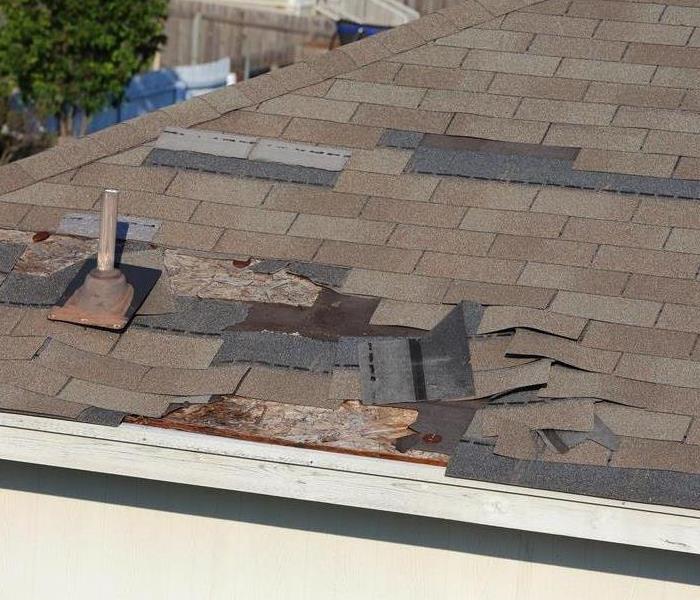 These four steps can minimize the extent of roof damage at your home in Stillwater, OK.
These four steps can minimize the extent of roof damage at your home in Stillwater, OK.
Adverse weather or high winds may damage your roof and lead to water damage in your home. Follow these four steps to mitigate roof damage after a storm until roofers arrive.
1. Assess the Damage
As soon as it is safe to access your roof, take a closer look to determine the best approach to limit damage. The best method depends on the type of roof. Fasten down boards, plastic, or tarp on a shingle roof. Cover leaky spots on tile or metal roofs any way that you can. Sweep standing water off of a flat roof to reduce seepage.
2. Board Up or Use Tarps
You may be able to limit the amount of water or debris that penetrates to the underlayerment of your roof or gets into your home by boarding up or covering leaky spots with plastic or tarp. If your home has a pitched shingle roof, use screws or nails to secure the cover. Make sure any material extends over the ridgeline to prevent water from working its way under the covering.
3. Funnel Water Flow
If your ceiling is holding water, situate a large bucket or trash can underneath and pierce the bulge with a sharp object such as a screwdriver or pen. Releasing pooling water can minimize damage. You may need to have extensive roof damage repairs and contact a service specializing in storm damage restoration to prevent mold.
4. Protect Belongings
Take measures to protect interior contents from leaks. Move delicate furniture and items away from the area for the time being. Use buckets or even a large trash can with wheels to catch water and limit damage.
These four steps can minimize the extent of roof damage at your home in Stillwater, OK. Whether storm or wind damage is the culprit, you should try to protect your home until roofing experts arrive. For more information, visit http://www.SERVPROstillwaterguthrie.com/.
Flood Safety Tips for First Responders
7/16/2018 (Permalink)
 In the aftermath of a storm, it’s important to stay safe if you plan to participate in first responder activities.
In the aftermath of a storm, it’s important to stay safe if you plan to participate in first responder activities.
After a storm in Stillwater, OK, floodwaters may contain hazardous materials such as raw sewage or chemicals. Individuals choosing to participate in flood response actions need to be aware of the potential health risks and take proper precautions. If you are a first responder after a flood event, here are four tips to help keep you safe from injury and illness.
1. Obtain recommended immunizations before exposure. If you have not received a tetanus shot within the last 10 years, the Center for Disease Control recommends getting a booster before beginning your flood recovery efforts. Additionally, if you have the potential to be exposed to human bodily fluids while caring for victims or patients, the Hepatitis B vaccine is also strongly encouraged.
2. Wear protective gear and clothing. Gloves should be worn at all times when dealing with the aftermath of a flood. Ideally, gloves should be both cut resistant and waterproof. Eye goggles can protect the eyes from infection or injury. If floodwater is still present, wearing waterproof coveralls over your clothes can provide additional protection.
3. Follow hygiene and sanitation procedures. Frequent handwashing is essential for a first responder due to the potential exposure to toxic materials. If clean water and soap are not readily available, hand sanitizer with alcohol can be used as a substitute.
4. Remain aware of hidden dangers. After a heavy flood, the ground may become unstable due to oversaturation of water, leading to unanticipated sinkholes or slides. Additionally, some areas are higher risk due to pesticides or other chemical-related runoff. Mold can rapidly set in after a flood event, so be aware of potential mold exposure. In any case, professional restoration specialists can help mitigate the risks of mold and lingering bacterial or chemical contamination.
In the aftermath of a storm, it’s important to stay safe if you plan to participate in first responder activities. By following a few safety tips like the ones listed above, you can help make an impact on the cleanup efforts without jeopardizing your health. For more information, visit http://www.SERVPROstillwaterguthrie.com/.
Why a Flood Policy is a Wise Investment
6/14/2018 (Permalink)
 Most flood policies come with a 30-day waiting period, so don't wait until the height of storm season to start shopping.
Most flood policies come with a 30-day waiting period, so don't wait until the height of storm season to start shopping.
If your commercial building is located in an area prone to flooding, whether or not you should have commercial flood coverage should not even be a question. However, many people assume that commercial insurance covers damage from disasters such as floods, an assumption that could end up costing them hundreds of thousands of dollars in the long run. Most commercial building insurance policies do not cover damage caused by floods, even if that same policy covers water damage caused by a burst pipe or leaky roof. If you want to reduce the financial impact of a flood as much as possible, look into a flood policy. There are several good reasons to do so:
• Floods are the nation's most common natural disaster, and they often result in millions of dollars of damage each year.
• Your commercial building policy likely does not cover flood damage.
• More than 20 percent of flood claims come from buildings outside of high-risk flood zones.
• You may be required to carry flood insurance, regardless of where your building is located.
How To Buy Flood Insurance
If you're interested in adding flood coverage to your commercial insurance policy, talk to your Stillwater, OK, insurance agent about doing so. Bear in mind that some insurance companies do not provide flood insurance. If that is the case, reach out to FEMA for a list of agents that do offer the desired coverage.
Before investing in a policy, ask the provider about what is and is not covered by the policy. Also, talk to your local flood damage restoration team about what type of coverage in which you should invest. A professional restoration team may know more about risks and exposures than your agent.
Most flood policies come with a 30-day waiting period, so don't wait until the height of storm season to start shopping. Talk to your commercial insurance agency today about tacking on the policies you need to protect your business. For more information, visit http://www.SERVPROstillwaterguthrie.com/.
6 Shutter Styles You May Need for Your Home
4/19/2018 (Permalink)
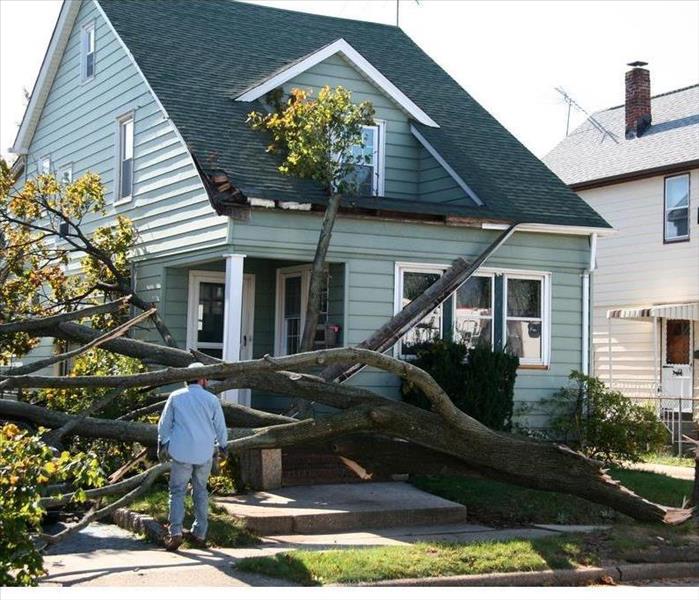 Having your home protected with hurricane window coverings can also save you money in the long run by lowering your insurance premiums.
Having your home protected with hurricane window coverings can also save you money in the long run by lowering your insurance premiums.
If you live in an area that is prone to hurricane and high winds, such as Stillwater, OK, you can mitigate potential damage to your home and protect family by installing storm shutters. Having your home protected with hurricane window coverings can also save you money in the long run by lowering your insurance premiums.
Many types of hurricane window coverings are available. Here are just a few of the more popular options.
1. Plywood
Plywood may not be pretty. However, it is usually an inexpensive, readily available option that can cost less than $1 per square foot of window space.
2. Storm Panels
Storm panels are often an economical option that may only need to be installed if a hurricane is imminent. The cost for these panels is $7-$15 per window.
3. Accordion-Style
Accordion-style window coverings can be stored folded up in a box that is secured to one side of the window. They can then be manually unfolded to cover the window when needed. These shutters often cost $15-$25 per square foot of window space.
4. Bahama Awnings
Bahama awnings can provide shade as well as protect windows from damage by high winds. These shutters can be installed on the tops of windows to provide awnings, and then can be unlatched when you need to cover the window. These coverings may cost about $15-$20 per square foot.
5. Rolling
These window coverings are typically installed in a box bolted above the window. A cranking mechanism unrolls the shutters across the length of the window, and then they are bolted down at the bottom. They can also provide effective insulation, helping to save costs of heating or cooling a home at a cost of $20-$30 per square foot of window area.
6. Colonial
Colonial storm shutters are usually mounted permanently on either side of a window and bolted in place. When needed, they can be unfolded to cover the window. Colonial-style window coverings cost about $200-$500 per window.
Expecting stormy weather? The next time high winds are forecast in your area, you can have peace of mind when you have quality window coverings installed for your home. For more information, visit http://www.SERVPROstillwaterguthrie.com/.
Home Safety After Storm Damage
2/19/2018 (Permalink)
Is your home safe after storm damage?
Are you suffering from storm damage? Do you have roof damage from high winds?
The first thing you need to do is make an emergency call to a home restoration company that specializes in storm mitigation so they can start the process of storm remediation. Do this before trying to clean your home by yourself. Wind damage may have caused your home to flood and have electrical damage. Be sure that your home is safe before entering.
River flooding and rain flooding can cause ground water to enter your home. These flood waters may carry an electrical current. It is best to let a storm damage and river flooding water restoration company deal with it first.
There is more information about storm restoration on our website www.SERVPROstillwaterguthrie.com.
How To Get Professional Storm Damage Restoration
2/18/2018 (Permalink)
Storm and flood cause some of the most devastating and frustrating situations you can face, and if not handled properly, they can lead to major structural damage and huge repair costs.
These situations can cause a significant amount of damage to a home and personal property including clothing, furniture, electronics and other belongings. These situations should be addressed promptly, by qualified professionals. That way you can be assured of no additional issues in the near future.
If you're experiencing problems, such as flooding, wind damage, hurricane damage, river flooding, wind damage, ice damming, frozen pipes, ice dam, roof damage or roof leak, you need to get a storm restoration company to provide home restoration or storm remediation. Restoration professionals know what to do and how to do it effectively and achieve successful outcome.
There is more information about storm restoration on our website www.SERVPROstillwaterguthrie.com.
Storm Restoration Starts With Roof Repair
2/18/2018 (Permalink)
Repairing the roof after storm damage.
It's important to get roof repair right away, after storm damage, wind damage or hail damage. The devastating effect of hail damage might not show up immediately. Also, it is important to get storm restoration professionals to have your roof inspected and provide roof repair right away, before the time you can file insurance claim expires.
A flood pump is an essential tool in a professional's arsenal. Buckets can be used to remove the flood water but a flood pump is needed to get rid of the excess flood water or ground water. A flood pump will also expedite the process of water removal and protect the floor from additional damage.
The water restoration and storm restoration efforts needed to deal with wind, hurricane, flooding or localized river flooding are often crucial for protecting the long-term value of a home.
For more information visit www.SERVPROstillwaterguthrie.com.
Why should I call a professional?
2/18/2018 (Permalink)
Make That Call to A Professional
Hurricane and flooding can cause severe damage to a home and it is important to take action and get professional assistance right away. Water restoration professionals will arrive at the location to assess the wind damage, roof damage, hail damage, river flooding and other issues such as ice damming, ice dam, ground water, and frozen pipes and create a customized plan for storm restoration or storm remediation.
Reliable professionals understand how devastating storm or flooding can be, and they are committed to providing home owners with restoration services to help them fix problems and prevent further damage to their property.
Home restoration involves several steps and having an experienced team of water restoration professionals will make things go smoothly.
SERVPRO of Stillwater / Guthrie has more services. Visit www. SERVPROstillwaterguthrie.com for more information.
Should I get my insurance involved after a storm?
2/18/2018 (Permalink)
Contact Your Insurance Company
The purpose of home insurance is to protect your home or property against losses that affect safety, functionality and value. If your home has sustained hail damage, roof leak, storm damage, hurricane damage, ice damage, wind damage or ground water, ice dam, ice damming, and frozen pipes your insurance policy should be able to cover the cost of home restoration and storm remediation.
But be sure to contact your insurance company as soon as possible to notify them of the ice damage, ice dam, ice damming or other storm damage issue such as hail damage, ground water, flood water, roof damage or roof leak so they know why you need roof repair, flood pump, water restoration or storm remediation. Insurance companies will often work with homeowners during a roof damage situation so that they can get quality roof repair.
For more information visit www.SERVPROstillwaterguthrie.com.
Leave the Cleaning to the Professionals
2/18/2018 (Permalink)
Flooding and Storm Damage Services
Your home is precious to you and your family. Having it destroyed boy a storm can be very devastating. If you are dealing with flooding from a storm do not hesitate to call the restoration experts of SERVPRO of Stillwater / Guthrie.
Home restoration professional are highly skilled and can address flooding or river flooding issues, as well as other storm damage situations such as flood water, ground water, roof damage or roof leak, hurricane damage, hail damage and ice damage and ensure a successful storm remediation. With the right team of water restoration professionals on your side, you can rest assured that your home restoration is in good hands.
SERVPRO of Stillwater / Guthrie has more services. Visit www. SERVPROstillwaterguthrie.com for more information.



 24/7 Emergency Service
24/7 Emergency Service

































